| |
Henry
Ford Unmasked at Last!!
|
|
This
exposé is under construction |
|
Click
on images to enlarge |
The
Ford Motor Company was a subsidiary of the Standard Oil Company!!
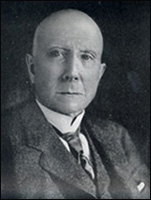
John D.
Rockefeller (1839-1937). |
| John
D. Rockefeller—the quintessential robber baron—was
a billionaire by 1910.
He
was the founder of the Standard Oil Company.
Around
1910, he financed Henry Ford in order to produce the
noisy air polluting gasoline engine and thus multiply
his ill-gotten fortune. |
|
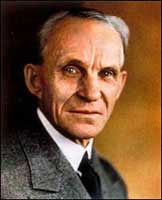
Henry
Ford (1863-1947).
|
In
1908, Henry Ford began mass production of the infamous gasoline air
polluting car known as the Model T. Most people in the U.S. believed
that automobiles would be powered by the newly developed wonder of
ELECTRICITY. What most people did not realize was that the Ford Motor
Company was a SUBSIDIARY of the Rockefeller owned Standard Oil Company.
When
the other car companies saw the vast profits that Ford was making
on his gasoline powered Model T, they abandoned the electric car,
and began to produce their own air polluting cars.
In
the early 20th century, National City Lines, which was a partnership
of General Motors, Firestone, and Standard Oil of California, purchased
many electric tram networks across the country to dismantle them and
replace them with GM buses. The partnership was convicted for this
conspiracy, but the ruling was overturned in a higher court. Electric
tram line technologies could be used to recharge BEVs and PHEVs on
the highway while the user drives, providing virtually unrestricted
driving range.
"Mr.
Electric" Thomas Edison ENCOURAGED Ford to produce gasoline powered
vehicles!!
Thomas
Alva Edison is a revered icon in the U.S. and around the world. Many
credit him with developing electricity and lighting up the world.
He was just another Rockefeller shill and Nikola
Tesla was the man who electrified the world—not Thomas Edison.
Edison—acting
under order from his boss Rockefeller—encouraged Henry Ford
in the development of the gasoline engine. As a matter of fact, Edison
and Ford were very good friends for all of their adult lives.
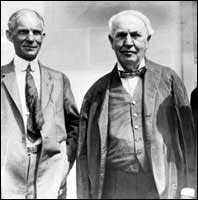
Henry
Ford and Thomas Edison became very close friends.
|
The
ONLY thing that Thomas Edison invented was the electric
chair.
He
fought Nikola Tesla's alternating
current system with relentless fury.
Eventually
his DC system was abandoned, and as revenge, he encouraged Ford
to produce the gasoline engine. |
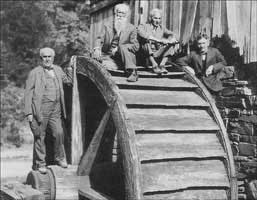
Thomas
Edison, John Burroughs, Henry Ford and Harvey Firestone on
a camping expedition in 1918.
|
Ford
looked on Edison as a sort of demigod. He finally got to meet his
hero at a convention in Atlantic City, New Jersey, in 1887. Here
is Ford's own account of their first meeting:
No
man exceeds Thomas A. Edison in broad vision and understanding.
I met him first many years ago when I was with the Detroit Edison
Company, —probably about 1887 or thereabouts. The electrical
men held a convention at Atlantic City, and Edison, as the leader
in electrical science, made an address. I
was then working on my gasoline engine, and most people, including
all of my associates in the electrical company, had taken pains
to tell me that time spent on a gasoline engine was time wasted—that
the power of the future was to be electricity. These criticisms
had not made any impression on me. I was working ahead with all
my might. But being in the same room with Edison suggested to me
that it would be a good idea to find out if the master of electricity
thought it was going to be the only power in the future. So, after
Mr. Edison had finished his address, I managed to catch him alone
for a moment. I told him what I was working on. At once he was interested.
He is interested in every search for new knowledge. And then I asked
him if he thought that there was a future for the internal combustion
engine. He answered something in this fashion. (Ford,
My Life and Work, p. 234).
Here
is Edison's reply to the future of the gasoline engine:
Yes,
there is a big future for any light-weight engine, that can develop
a high horsepower and be self-contained. No one kind of motive power
is ever going to do all the work of the country. We do not know what
electricity can do, but I take for granted that it cannot do everything.
Keep on with your engine. If you can get what you are after, I can
see a great future.
(Ford, My Life and Work, pp. 234-235).
George B. Selden
was the U.S. inventor of the automobile!!
The
horseless carriage or automobile was the next step in the evolution
of the steam engine. By 1885, many countries, especially France and
Germany, had gasoline powered automobiles.
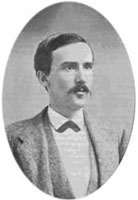
George
B. Selden (1846-1922). U.S. inventor of the automobile.
|
George
B. Selden patented the automobile in 1877.
It ran
on gas, had power steering and was turbocharged. |
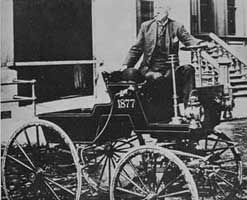
George
B. Selden with his automobile. |
George
B. Selden filed the first patent for an internal combustion powered
automobile in 1879. Selden was a Civil War veteran from Rochester,
New York. He was a close friend of camera inventor, George Eastman.
Selden's
father, Henry Selden, was chosen by Abraham Lincoln to be Vice President,
but he turned it down (and in light of Lincoln's assassination, Henry
Selden would have otherwise been the next U.S. President).
After
the war, he studied engineering at Yale, where the great U.S. scientist
J. Willard Gibbs was one of his teachers.
Selden
had to drop out when his father died, so he studied law and passed
the bar exam in 1871. He knew his patent could protect him for only
seventeen years, once it was issued. It was unlikely that he could
produce cars and create a market for them that soon.
Seldon
kept delaying the patent process until he was issued a patent for
his automobile in 1895.
Selden
applied for a patent on the "Road Engine" in 1879. Sensing
that the time was not right for a horseless carriage, he delayed issuance
of the patent until 1895, by which time the young automobile industry
was growing in the U.S. Although he had no interest in manufacturing
his invention, he was very interested in benefiting from it.
Under
threat of suit, almost all of the manufacturers took out licenses
from Selden, or from the Association of Licensed Automobile Manufacturers
(ALAM), to whom he sold the patent. In fact, on most cars built during
the next ten or fifteen years you will find a small brass plaque reading
"Manufactured under Selden Patent." Manufacturers were only
required to pay the very small sum of 1 percent of their yearly earnings.
Henry
Ford refused to abide by the Selden patent. He actually said that
"Selden and his patent can go to hell."
The
case came to court, and at first the court ruled against Ford. With
the help of Rockefeller money, Ford appealed, and the court overturned
the previous decision and ruled for Ford.
|
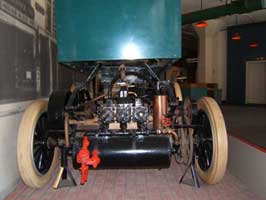
Rear
view of Selden automobile. |
Selden
held the patent for most types of automobiles, including the
steering wheel.
Ford—with
the help of Rockefeller money—was able to circumvent the
Selden patent. |
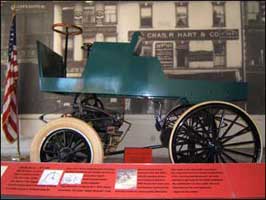
The
Selden automobile is now housed in a museum. |
Two
Selden patent autos still exist. One is in the Connecticut State Library
in Hartford, Conn., and the other is in of all places the Henry Ford
Museum in Dearborn, Michigan. The Selden auto was a front wheel drive,
turbo charged gas turbine engine mounted on the common buggy of the
day. It was light years ahead of anything that Henry Ford produced.
In
the beginning, Ford's autos had no steering wheel with just a tiller
to steer the car. There can be just 2 reasons for this obvious oversight:
| 1. |
Ford
did not know how to add a steering wheel. |
| 2. |
Ford
knew that he was infringing on the Selden patent and modified
his car by omitting a steering wheel. |
The
second reason is more plausible because Ford raced against cars with
steering wheels which were manufactured under the Selden patent. Under
the Selden patent, manufacturers were required to pay a little over
1 percent of their total earnings for the year. Nobody complained
or refused to pay but Ford. He did not want to acknowledge that his
car was a blatant infringement of the Selden patent.
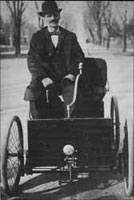
First
Ford "car" called a Quadricycle made its debut in
1896. Notice it had no steering wheel.
|
Ford
was not allowed to produce a car with a steering wheel because
it was a violation of the Selden patent.
Ford
said that steering wheels were not yet invented!! |
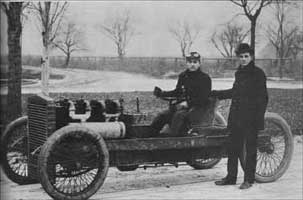
Henry
Ford with race car driver Barney Oldfield in 1901. Notice
the car still has no steering wheel. |
Henry Ford and
the Model T
Ford
was a nobody until 1914 when he announced a $5.00 per day pay scale
for his workers. This move brought him nationwide publicity.
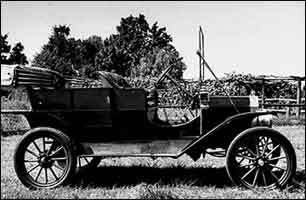
1909 Ford
Model T. |
By
1909, Ford cars had steering wheels, thanks to Rockefeller money
to buy the judge in the Selden patent. |
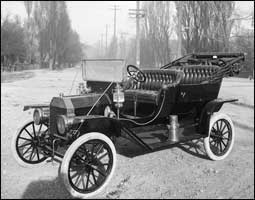
1910 Ford
Model T. |
Henry
Ford's ugly gasoline powered Model T was nicknamed the Tin Lizzy or
the Flivver. It did have a steering wheel. By 1925, only his sponsor,
John D. Rockefeller, had more money.
Ford
was a nobody until 1914 when he announced a $5.00 per day pay scale
for his workers. This move brought him nationwide publicity.
Hundreds
of thousands of men from all over the U.S. arrived in Detroit, and
Ford had the pick of the youngest and strongest, to man his mass production
rapidly moving assembly line.
In
order for the men to qualify for the $5.00 per day pay scale they
had to meet certain criteria set up by Ford. He set up a special department
modeled after the Inquisition called the Sociology Department. The
initial staff consisted of 30 "investigators" who visited
the homes of all his workers and noted every detail of their private
lives. Any worker who got divorced, used alcohol, or took in boarders
was disqualified from the higher pay scale. Here is a quote from a
Ford biography:
At
its worst, the new department was a mildly tyrannical instrument which
sowed the seeds of inquisition at the Ford Motor Co. Its agents became,
to some extent, collectors of tales and suspicions. Examined on their
doorsteps, wives were called upon to testify against husbands, children
against parents. Hearsay as well as fact found its way to a card catalogue
where a record was kept of every worker's deviations. To avoid getting
demerits in this index, the wily Ford employees sometimes beat the
game by only pretending an interest in the rules. To some extent,
prying induced lying. As Ford was to put it in his autobiography,
his home visitors made an effort to break up the "evil custom"
of taking in male boarders. To get around this prohibition, certain
of his workmen and their wives simply passed off lodgers as "brothers"
or "cousins. (Sward, The Legend of Henry Ford,
p. 59).
Henry
Ford's Service Department!!
In
1931, Ford employed an ex-boxer and "tough guy" named Harry
Bennett to head up his security division or Service Department as
it was euphemistically called.
Eventually Bennett had the largest private army of thugs,
hoodlums and ex-convicts in the world. Ford deferred to him in EVEYTHING.
He ran the Ford Motor Company with an iron fist. Hitler's Gestapo
was modeled after the Ford Service Department, with its army of ruffians
and thugs.
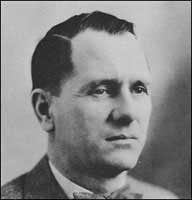
"Tough
guy" Harry Bennett (1892-1979) ran the Ford Motor Co.,
from about 1930 to 1947. |
Adolf
Hitler was a great admirer of Henry Ford and he modeled the
Gestapo after the Ford Service Department. |
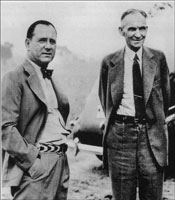
Henry
Ford with his second in command Harry Bennett. |
This
"tough guy" ran the Ford Motor Company from 1930 to the
death of Ford in 1947. He TERRORIZED everybody, except old man Ford
himself. He had links to all the underworld figures in Detroit.
Hitler
greatly admired and copied everything that Ford did. This is where
he got the idea for his own private army called the Gestapo, with
Himmler taking the place of Bennett.
Bennett
liked boxers and wrestlers as well as college athletes, and many
of them, particularly the big tough ones, ended up on the payroll.
Ford had long shown an interest in the redemption of ex-convicts,
and had given many of them a second chance. Bennett continued the
policy, with adaptations. He encouraged the thugs and hoodlums to
continue their line of work in the plant. He also sought out tough
cops and hired them. With this material he built up a small army
of goons who kept the workers under complete control. Anyone doing
anything naughty, like talking union, was beaten to a pulp and fired
for starting a fight.
(Herndon, Ford: An Unconventional Biography of the Men and their
Times, p.163).
The
Battle of the Overpass or Ford's Service Dept. in action!!
The
Battle of the Overpass, which took place on May 26, 1937, was an example
of Ford's Service Department in action. The workers HATED the police
state at the Ford factories but even thinking about joining
a union could get you fired . . . after a severe beating
from Bennett's bullies:
When
leaders of the United Automobile Workers obtained a permit from the
city of Dearborn to distribute handbills in front of the Rouge plant
on May 26, 1937, reporters and photographers made arrangements to
cover the event in full force. Bennett did too. UAW leaders, including
Walter Reuther and Richard Frankensteen, went to the pedestrian bridge
over Miller Road to Gate 4. Among the men waiting for them were Bennett's
boys, including professional boxers, wrestlers, and hoodlums. The
guards moved in on the union men from either side of the overpass
and trapped them there. Suddenly the guards pulled Frankensteen's
coat back over his shoulders and while he was unable to protect himself
with his arms others began hitting him in the face and body. They
knocked him down, then kicked him in the head, kidneys, and testicles.
Reuther was worked over, and dragged down the 36 iron steps. Another
man's back was broken. The thugs then turned on the other union people,
including several women. One girl, kicked in the stomach, vomited.
Those who could still move retreated, dragging their wounded with
them. (Herndon, Ford: An Unconventional Biography
of the Men and their Times, p.172).
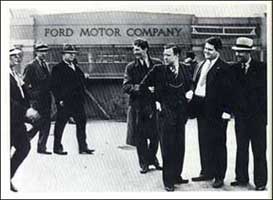
Union
organizers exercising their Constitutional right to freedom
of speech and of the press as Bennett's "Gestapo"
approach.
|
|
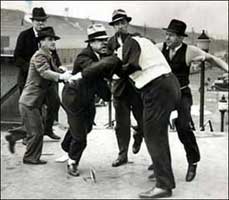
One of
the organizers, Richard Frankensteen, was attacked by the
goons.
|
| 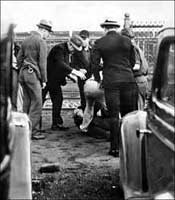
Bennett's
bullies attacking an unknown organizer. |
|
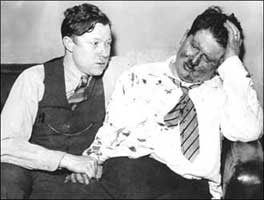
After
the Battle of the Overpass; Walter Reuther on the left and Richard
Frankensteen on the right. |
The
reporters witnessed the entire event and photographers took pictures,
but after the fight was over, the goon squad turned on the press.
They tore the reporters' notes from their hands, grabbed and smashed
the photographers' cameras. One photographer escaped. He ran to
the edge of the overpass and dropped his camera into an open convertible,
which sped away. In the camera was the complete photographic record
of the assault, and the pictures were printed all over the world.
(Herndon,
Ford: An Unconventional Biography of the Men and their Times,
pp. 172-173).
Thanks
to the miraculous preservation of the photographic record; the world
at last found out what was really going on behind the scenes at the
Ford fiefdom:
The
reporters buttressed their stories of the Battle of the Overpass with
accounts of eyewitnesses, including a minister, and, after having
been pushed around themselves, they pulled no punches once back in
the safety of their offices. If anyone had not known what was going
on at Ford's, they did then. In the face of the photographic evidence,
Henry Ford denied the whole thing. Edsel Ford sought to negotiate
with the union but had been told by his father to stay away and let
Bennett handle the problem. He must have been almost as sick to his
stomach as the girl who got kicked. Sorensen said that during this
period Edsel determined to resign, but Sorensen talked him into staying.
Edsel insisted on at least attempting to bring about union negotiations,
but his father told him flatly, in a direct way, not to interfere.
Most of the workers in the plant shared his discomfort more directly,
for, after the physical defeat of the union, Bennett unleashed his
full tactics of terror and brutality on the men. (Herndon,
Ford: An Unconventional Biography of the Men and their Times,
p.173).
Ford's
only son Edsel was totally disgusted with the behavior of the Service
Department and urged his father to negotiate with the union. The aroused
the enmity of his father and was one of the reasons why his father
had him murdered in 1943.
Ford's
B-24 bomber factory never got off the ground!!
When
Ford financed Adolf Hitler declared war on the U.S. in Dec. 1941,
Hitler was sure that his Ford financier would do EVERYTHING in his
power to ensure a Nazi victory. Ford did not disappoint him. In 1941,
the U.S. government gave Ford the staggering sum of 200 MILLION dollars
to build a state of the art bomber factory. Ford boasted that he would
soon be producing a bomber every hour.
| 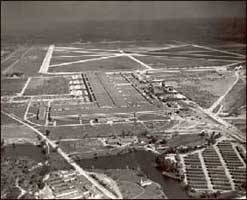
Willow
Run bomber factory— the largest in the world—was
built by Ford for the staggering sum of 200 MILLION dollars.
|
Ford financed
Hitler before the war and he was very reluctant to have his
factories in Germany and France bombed.
That is
why Willow Run bomber factory never really got off the ground.
Working
too fast at that factory could get you FIRED!!
|
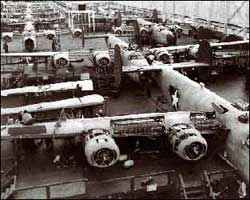
Willow
Run was later called Will-it Run? because they only produced
a total of about 8,000 bombers during the entire war.
|
Willow
Run was about 30 miles from Detroit with only 2 railway lines connecting
it to the city. Ford forgot to build housing for his workers.
None of Bennett's goons harassed the workers at that factory
for not producing. As a matter of fact, working too fast could get
you fired!!
Instead
of one plane an hour as Ford boasted, the factory only produced a
total of 8,000 planes during the entire war. That was quite OK with
Ford because he didn't want any bombs falling on his friend Hitler
or on his busy Ford factories in Germany and France.
Adolf
Hitler said this about his friend Henry Ford:
He
(International Jew) already sees the present-day European states as
will-less tools in his fist, whether indirectly through a so-called
Western democracy, or in the form of direct domination by Jewish Bolshevism.
But it is not only the Old World that he holds thus enmeshed, the
same fate menaces the New. It is Jews who govern the stock exchange
forces of the American Union. Every year makes
them more and more the controlling masters of the producers in a nation
of one hundred and twenty millions; only a single great man, Ford,
to their fury, still maintains full independence.
(Adolf Hitler, Mein Kampf,
p. 639).
Edsel Ford was
murdered in 1943
Edsel
Ford, the only son of Henry, was president of the Ford Motor Company
from 1919 to 1943. As president, he was only a figurehead, as the
company was run by Ford and Bennett.
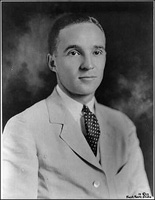
Edsel
Bryant Ford (1893-1943). |
Edsel
Ford was a Ford with a human face.
He
never agreed with his father's Gestapo tactics and therefore
he had a timely demise.
A
car was named after him called the Edsel. It was a colossal
flop for Ford.
If
all gasoline powered cars were flops like the Edsel, Islam would
be extinct today. |
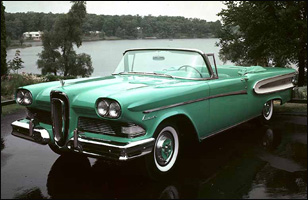
The
1958 Ford Edsel was a flop. |
Edsel
was a Ford with a human face totally opposite in temperament to his
father. He clashed with his father over the brutal treatment of the
workers and was determined to resign several times.
When
he saw the Willow Run factory producing inferior planes and lying
idle most of the time he was disgusted and threatened to resign.
Fascist
Henry Ford would do ANYTHING to ensure a Nazi victory even to having
his own son killed:
For
the next two years, Sorensen says, the irascible old man hammered
away at his son through Bennett, and in April of 1943 he landed the
heaviest blow yet. Ford ordered Sorensen to change Edsel's attitude
on several major points. Edsel was to cooperate with Bennett on all
matters in general, labor discord in particular, to break up his relationship
with his old friend Kanzler, and to "regain health by cooperating
with Henry Ford." Sorensen was convinced that Bennett was responsible
for the whole thing, but he had no choice but to pass on the father's
wishes. Edsel said there was nothing left for him to do but to resign.
Sorensen again dissuaded him. A month later Edsel was dead. Henry
Ford was smitten with grief. (Herndon, Ford: An
Unconventional Biography of the Men and their Times, pp.175-176).
"Doctor"
Henry Ford actually told his son that he could regain his health by
cooperating with Bennett.
Vital
links
Thomas
Edison unmasked at last!!
Henry
Ford and the Nazis
References
Collier,
Peter & Horowitz, David. The Fords. An American Epic.
Summit Books, New York, 1987.
Dominguez,
Henry. Edsel. The Story of Henry Ford's Forgotten Son. Society
of Automotive Engineers, Inc., Warrendale, PA. 2002.
Ford,
Henry. My Life and Work. Doubleday, Page & Co., Garden
City, NY, 1922.
Herndon,
Booton.Ford, An Unconventional Biography of the Men and their
Times. Weybright & Talley, New York, 1969.
Hitler,
Adolf. Mein Kampf (Translated by Ralph Manheim). Houghton
Mifflin Co, New York, 1939.
Greenleaf,
William. Monopoly on Wheels, Henry Ford & the Selden Automobile
Patent. Wayne State University Press, Detroit, 1961.
Lacey,
Robert. Ford: The Men and the Machine. Little, Brown &
Co., Boston, 1986.
Pool
James & Suzanne, Who Financed Hitler: The Secret Funding of
Hitler's Rise to Power 1919-1933. The Dial Press, New York, 1978.
Sward,
Keith.The Legend of Henry Ford. Rinehart & Co., New York,
1948.
Sinclair,
Upton.The Flivver King. A Story of Ford-America. Charles
H. Kerr Pub., Co., Chicago 1999. (Reprinted from 1937 edition).
Watts,
Steven.The People's Tycoon. Henry Ford and the American Century.
Alfred A. Knopf, New York, 2005.
Copyright
© 2007 by Niall Kilkenny
Back to Main Menu
|





















